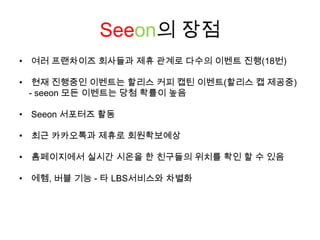1 of 6
Download to read offline






Ad
Recommended
Credence story 001 ļ¬©ļ”¼ĒśĖĒģöĒöäļĪ£ņĀØĒŖĖ(ĒĢ®ļ│Ė)
Credence story 001 ļ¬©ļ”¼ĒśĖĒģöĒöäļĪ£ņĀØĒŖĖ(ĒĢ®ļ│Ė)Credence Investment Co., Ltd.
╠²
Ēü¼ļĀłļŹśņŖż ņŖżĒåĀļ”¼ ņĀ£1ĒÄĖ ļ¬©ļ”¼ĒśĖĒģöĒöäļĪ£ņĀØĒŖĖ ņ×ģļŗłļŗż.PMI - ĒöäļĪ£ņĀØĒŖĖĻ┤Ćļ”¼ ņ×ÉĻ▓®ņ”ØņØä ļö░ņĢ╝ĒĢĀĻ╣īņÜö? ( Brochure)
PMI - ĒöäļĪ£ņĀØĒŖĖĻ┤Ćļ”¼ ņ×ÉĻ▓®ņ”ØņØä ļö░ņĢ╝ĒĢĀĻ╣īņÜö? ( Brochure)PMI South Korea Chapter
╠²
PMI - ĒöäļĪ£ņĀØĒŖĖĻ┤Ćļ”¼ ņ×ÉĻ▓®ņ”ØņØä ļö░ņĢ╝ĒĢĀĻ╣īņÜö? ĻĖ░ņłĀĻ░Ćņ╣śĒÅēĻ░Ć ņĀ£ņĢłņä£ ņØ┤ņĢöĒŚłļĖī 130618
ĻĖ░ņłĀĻ░Ćņ╣śĒÅēĻ░Ć ņĀ£ņĢłņä£ ņØ┤ņĢöĒŚłļĖī 130618ņØ┤ņĢöĒŚłļĖī ņŻ╝ņŗØĒÜīņé¼
╠²
ņØ┤ņĢöĒŚłļĖīņØś ĻĖ░ņłĀĻ░Ćņ╣śĒÅēĻ░ĆņŚÉļŖö
ņÖĖļČĆņØś ņŗ£ņןļÅÖņØĖ, ĻĖ░ņłĀņØś ĒĢĄņŗ¼Ļ░Ćņ╣ś, ņ×¼ļ¼┤ņĀü ļģ╝ļ”¼ņä▒ņŚÉ ļīĆĒĢ┤ ļ¬ģĒÖĢĒĢ£ ļ░®Ē¢źņØä ņĀ£ņŗ£ĒĢ®ļŗłļŗż.SCALe_New media_architecture_ņāüļÅäļÅÖ ĒśĖĒģö
SCALe_New media_architecture_ņāüļÅäļÅÖ ĒśĖĒģöscale_kr
╠²
SCALe New Media Architecture Design
ņāüļÅäļÅÖ ĒśĖĒģö ĒöäļĪ£ņĀØĒŖĖ(ĒīīļØ╝ļŗżņØ┤ņŖżĒśĖĒģöņä£ļ╣äņŖżļööņ×ÉņØĖņé¼ļĪĆ)ĒīĆņØĖĒä░ĒÄśņØ┤ņŖż 111005
(ĒīīļØ╝ļŗżņØ┤ņŖżĒśĖĒģöņä£ļ╣äņŖżļööņ×ÉņØĖņé¼ļĪĆ)ĒīĆņØĖĒä░ĒÄśņØ┤ņŖż 111005teaminterface
╠²
Service Design Case StudyFinancial Management: Risk and Rates of Return
Financial Management: Risk and Rates of Returnpetch243
╠²
This document discusses risk and rates of return in investments. It defines different types of risk like stand-alone risk and portfolio risk. It shows how to calculate expected returns, standard deviation as a measure of risk, and the coefficient of variation to compare risk-adjusted returns. It introduces the Capital Asset Pricing Model (CAPM) and how it uses beta to measure non-diversifiable market risk and determine required rates of return based on the security market line. It provides examples of calculating betas, expected returns, and portfolio risk measures like standard deviation and required returns.GDS Systems Overview
GDS Systems OverviewEdutour
╠²
Global Distribution Systems (GDS) started in the 1950s to automate airline reservations which were previously done with index cards. The first GDS, SABRE, was created through a partnership between American Airlines and IBM in 1960. There are now four major GDS: Amadeus, Sabre, Galileo, and Worldspan. GDS allow travel agencies to book flights, hotels, and other travel services. However, airlines have sought to reduce their reliance on GDS and associated fees by establishing their own direct booking channels. This has led to increased competition and new entrants trying to replace the traditional GDS model.Risk And Return Of Security And Portfolio
Risk And Return Of Security And Portfolioshekhar sharma
╠²
- Peter Lynch purchased 100 shares of Iomega Corp. 3 months ago at $50 per share. He received $0.25 dividends per share last month. The shares are now worth $56 each.
- The document discusses concepts related to risk and return such as random variables, probability, moments, variance, standard deviation, and covariance. It provides an example of computing these statistics for two companies.
- Portfolio theory holds that combining securities reduces risk through diversification. The correlation between securities also impacts the risk of a portfolio. The portfolio with the highest expected return for a given level of risk makes up the efficient frontier.Risk, return, and portfolio theory
Risk, return, and portfolio theoryLatha Chilukamarri C
╠²
The document discusses risk and return in investments. It defines key concepts such as realized and expected return, ex-ante and ex-post returns, sources and measurements of risk including standard deviation and coefficient of variation. It also discusses the risk-return tradeoff and how higher risk investments require higher potential returns to compensate for additional risk.Chapter 08 Risk & Return
Chapter 08 Risk & ReturnAlamgir Alwani
╠²
The document discusses risk and return in investing. It explains that equity investments like stocks historically have higher average returns of over 10% compared to debt investments like bonds that return 3-4%, but stocks are also more volatile. It defines risk as the variability of returns, and introduces the concepts of systematic risk that affects all stocks equally and unsystematic risk that is specific to individual stocks. Diversification can reduce unsystematic risk but not systematic risk. It also discusses measuring market risk through a stock's beta value, which represents its volatility relative to the overall market.Risk And Return
Risk And ReturnAl Razaq Muhammad
╠²
The document discusses the relationship between risk and return when investing. It states that there is a trade-off between expected risk and expected return, with higher risk investments typically offering higher returns to compensate investors for taking on more risk. It also discusses how diversification across multiple assets can reduce the non-systematic/diversifiable risk in a portfolio, but not the systematic/market risk that is related to movements in the overall market. The document defines beta as a measure of a stock's systematic risk relative to the market.Risk & return analysis
Risk & return analysismishrakartik244
╠²
1) Total risk of a security is composed of systematic risk, which stems from external market factors, and unsystematic risk, which is specific to a company.
2) Diversifying a portfolio by holding many securities with returns that are not perfectly positively correlated can reduce total risk through lowering unsystematic risk exposure.
3) The degree of risk reduction from diversification depends on the correlation between the returns of the securities in the portfolio. Perfectly negatively correlated securities eliminate risk, while perfectly positively correlated securities do not allow for risk reduction through diversification.How to Size a Market Opportunity ŌĆö Fast
How to Size a Market Opportunity ŌĆö FastOpenView
╠²
The document provides a comprehensive overview of market sizing methodologies, including definitions and calculations for total market potential, total addressable market (TAM), segmented addressable market (SAM), and expected share of addressable market (ESAM). It discusses various approaches to market sizing such as top-down, bottom-up, and triangulation, highlighting practical examples of market analysis for different industries. Additionally, the document emphasizes the importance of resource constraints and the challenges associated with accurate market estimation.More Related Content
Viewers also liked (9)
(ĒīīļØ╝ļŗżņØ┤ņŖżĒśĖĒģöņä£ļ╣äņŖżļööņ×ÉņØĖņé¼ļĪĆ)ĒīĆņØĖĒä░ĒÄśņØ┤ņŖż 111005
(ĒīīļØ╝ļŗżņØ┤ņŖżĒśĖĒģöņä£ļ╣äņŖżļööņ×ÉņØĖņé¼ļĪĆ)ĒīĆņØĖĒä░ĒÄśņØ┤ņŖż 111005teaminterface
╠²
Service Design Case StudyFinancial Management: Risk and Rates of Return
Financial Management: Risk and Rates of Returnpetch243
╠²
This document discusses risk and rates of return in investments. It defines different types of risk like stand-alone risk and portfolio risk. It shows how to calculate expected returns, standard deviation as a measure of risk, and the coefficient of variation to compare risk-adjusted returns. It introduces the Capital Asset Pricing Model (CAPM) and how it uses beta to measure non-diversifiable market risk and determine required rates of return based on the security market line. It provides examples of calculating betas, expected returns, and portfolio risk measures like standard deviation and required returns.GDS Systems Overview
GDS Systems OverviewEdutour
╠²
Global Distribution Systems (GDS) started in the 1950s to automate airline reservations which were previously done with index cards. The first GDS, SABRE, was created through a partnership between American Airlines and IBM in 1960. There are now four major GDS: Amadeus, Sabre, Galileo, and Worldspan. GDS allow travel agencies to book flights, hotels, and other travel services. However, airlines have sought to reduce their reliance on GDS and associated fees by establishing their own direct booking channels. This has led to increased competition and new entrants trying to replace the traditional GDS model.Risk And Return Of Security And Portfolio
Risk And Return Of Security And Portfolioshekhar sharma
╠²
- Peter Lynch purchased 100 shares of Iomega Corp. 3 months ago at $50 per share. He received $0.25 dividends per share last month. The shares are now worth $56 each.
- The document discusses concepts related to risk and return such as random variables, probability, moments, variance, standard deviation, and covariance. It provides an example of computing these statistics for two companies.
- Portfolio theory holds that combining securities reduces risk through diversification. The correlation between securities also impacts the risk of a portfolio. The portfolio with the highest expected return for a given level of risk makes up the efficient frontier.Risk, return, and portfolio theory
Risk, return, and portfolio theoryLatha Chilukamarri C
╠²
The document discusses risk and return in investments. It defines key concepts such as realized and expected return, ex-ante and ex-post returns, sources and measurements of risk including standard deviation and coefficient of variation. It also discusses the risk-return tradeoff and how higher risk investments require higher potential returns to compensate for additional risk.Chapter 08 Risk & Return
Chapter 08 Risk & ReturnAlamgir Alwani
╠²
The document discusses risk and return in investing. It explains that equity investments like stocks historically have higher average returns of over 10% compared to debt investments like bonds that return 3-4%, but stocks are also more volatile. It defines risk as the variability of returns, and introduces the concepts of systematic risk that affects all stocks equally and unsystematic risk that is specific to individual stocks. Diversification can reduce unsystematic risk but not systematic risk. It also discusses measuring market risk through a stock's beta value, which represents its volatility relative to the overall market.Risk And Return
Risk And ReturnAl Razaq Muhammad
╠²
The document discusses the relationship between risk and return when investing. It states that there is a trade-off between expected risk and expected return, with higher risk investments typically offering higher returns to compensate investors for taking on more risk. It also discusses how diversification across multiple assets can reduce the non-systematic/diversifiable risk in a portfolio, but not the systematic/market risk that is related to movements in the overall market. The document defines beta as a measure of a stock's systematic risk relative to the market.Risk & return analysis
Risk & return analysismishrakartik244
╠²
1) Total risk of a security is composed of systematic risk, which stems from external market factors, and unsystematic risk, which is specific to a company.
2) Diversifying a portfolio by holding many securities with returns that are not perfectly positively correlated can reduce total risk through lowering unsystematic risk exposure.
3) The degree of risk reduction from diversification depends on the correlation between the returns of the securities in the portfolio. Perfectly negatively correlated securities eliminate risk, while perfectly positively correlated securities do not allow for risk reduction through diversification.How to Size a Market Opportunity ŌĆö Fast
How to Size a Market Opportunity ŌĆö FastOpenView
╠²
The document provides a comprehensive overview of market sizing methodologies, including definitions and calculations for total market potential, total addressable market (TAM), segmented addressable market (SAM), and expected share of addressable market (ESAM). It discusses various approaches to market sizing such as top-down, bottom-up, and triangulation, highlighting practical examples of market analysis for different industries. Additionally, the document emphasizes the importance of resource constraints and the challenges associated with accurate market estimation.Seeon
- 2. Seeon?Seeon- 2010ļģä 8ņøö15ņØ╝ ļ¤░ņ╣Ł(ņĢäņØ┤ĒÅ░) - 2010ļģä 9ņøö 27ņØ╝ ņĢłļō£ļĪ£ņØ┤ļō£ņČ£ņŗ£Ļ│ĄņŗØ ĒÖłĒÄśņØ┤ņ¦Ć, ļĖöļĪ£ĻĘĖ, ĒŖĖņ£äĒä░ļĪ£ ņ£ĀņĀĆļōżĻ│╝ ņåīĒåĄĒĢśĻ│Ā ņ׳ņØī
- 3. Seeon?ļĖöļĪ£ĻĘĖ ņØ╝ņØ╝ ļ░®ļ¼Ėņ×É ņłś 100ļ¬ģ ļé┤ņÖĖĒŖĖņ£äĒä░ĒīöļĪ£ņÜ░3300ņŚ¼ļ¬ģSeeonĻ░Ćņ×ģņ×Éņłś 20ļ¦īļ¬ģ(seeonļ░£Ēæ£ļé┤ņÜ®)ņś¼ĒĢ┤ ļ¦żņČ£ 50ņ¢ĄņøÉņØä ļ¬®Ēæ£
- 4. SeeonņØś ņןņĀÉņŚ¼ļ¤¼ Ēöäļ×£ņ░©ņØ┤ņ”ł ĒÜīņé¼ļōżĻ│╝ ņĀ£Ē£┤ Ļ┤ĆĻ│äļĪ£ ļŗżņłśņØś ņØ┤ļ▓żĒŖĖ ņ¦äĒ¢ē(18ļ▓ł)Ēśäņ×¼ ņ¦äĒ¢ēņżæņØĖ ņØ┤ļ▓żĒŖĖļŖö ĒĢĀļ”¼ņŖż ņ╗żĒö╝ ņ║ĪĒŗ┤ ņØ┤ļ▓żĒŖĖ(ĒĢĀļ”¼ņŖż ņ║Ī ņĀ£Ļ│Ąņżæ) - seeonļ¬©ļōĀ ņØ┤ļ▓żĒŖĖļŖö ļŗ╣ņ▓© ĒÖĢļźĀņØ┤ ļåÆņØīSeeonņä£ĒżĒä░ņ”ł ĒÖ£ļÅÖņĄ£ĻĘ╝ ņ╣┤ņ╣┤ņśżĒåĪĻ│╝ ņĀ£Ē£┤ļĪ£ ĒÜīņøÉĒÖĢļ│┤ņśłņāüĒÖłĒÄśņØ┤ņ¦ĆņŚÉņä£ ņŗżņŗ£Ļ░ä ņŗ£ņś©ņØä ĒĢ£ ņ╣£ĻĄ¼ļōżņØś ņ£äņ╣śļź╝ ĒÖĢņØĖ ĒĢĀ ņłś ņ׳ņØīņŚÉĒŚ┤, ļ▓äļĖö ĻĖ░ļŖź - ĒāĆ LBSņä£ļ╣äņŖżņÖĆ ņ░©ļ│äĒÖö
- 5. SeeonņØś ļŗ©ņĀÉĒżņŖżĒĆśņ¢┤ņØś ņןņĀÉņØä ĒÖ£ņÜ®Ē¢łņ¦Ćļ¦ī ļööņ×ÉņØĖņŚÉ ļŗ©ņĪ░ļĪ£ņøĆņØ┤ ņĪ░ĻĖł ņ£Āņ╣śĒĢ┤ ļ│┤ņ×äĒ׳ņŖżĒåĀļ”¼ļĪ£ ļö░ļĪ£ Ļ┤Ćļ”¼ļÉśņ¦Ć ņĢŖņØīĻĖĆļĪ£ļ▓īĒÖö ĒĢśĻĖ░ņŚÉļŖö OSņØś ļŗżņ¢æņä▒ņØ┤ ļ¢©ņ¢┤ņ¦Éņä£ĒżĒä░ņ”łĻ░Ć ĒÖ£ļÅÖĒĢśņ¦Ćļ¦ī ĒżņŖżĒĆśņ¢┤Ļ░ÖņØĆ ļ¬©ņ×äņØĆ ņŚåĻ│Ā ņ╣£ļ¬®ĒÖ£ļÅÖļ¦ī ĒĢśĻ│Ā ņ׳ņØī(seeonņäżļ¬ģ)
- 6. Ē¢źĒøä ļ░£ņĀä ļ░®Ē¢źĻĄŁļé┤ Ēöäļ×£ņ░©ņØ┤ņ”ł ņØ┤ļ▓żĒŖĖ ņ¦ĆņåŹ ņŗ£Ē¢ēņśłņĀĢņ¦ĆņåŹņĀüņØĖ ņŚģĻĘĖļĀłņØ┤ļō£ļĪ£ ĻĄŁļé┤ LBSņżæ ņä▒ņן Ļ░ĆļŖźņä▒ņØ┤ ļåÆņĢä ļ│┤ņ×äĒżņŖżĒĆśņ¢┤ ļ¬©ļ░®ņŚÉņä£ ļ▓Śņ¢┤ļéś ļÅģņ×ÉņĀüņØĖ ņĢäņØ┤ļööņ¢┤ļĪ£ ņ¦äĒ¢ēņżæ
